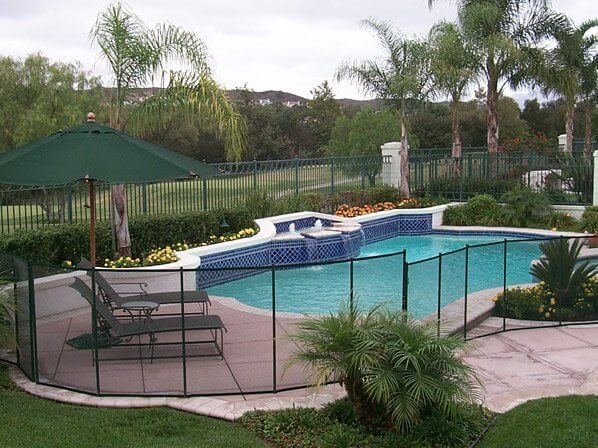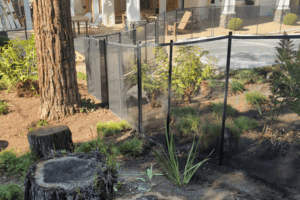
Upgrading Your Existing Pool Fence: DIY Options for 2025
Find the best pool fence options for upgrading your DIY removable mesh pool fence. These are our top suggestions to get the pool fence idea juices flowing.
Home > Pool Safety Fences: Everything You Need to Know

Every All-Safe pool fence and gate is built to be attractive and durable. Safety fences are removable and are designed with transparent mesh that acts as a reliable layer of protection around your pool. These mesh panels are resistant to abrasion, mildew, and sunlight, so they will never shrink, rip, or fade and kids won’t be able to easily poke through them during playtime.
All-Safe’s team of well-trained technicians are highly qualified to install the concentric tension-based fencing system we customize for your swimming pool. We can incorporate existing structures like exterior walls or build it as a freestanding addition to your yard. The fencing system can also include self-closing, self-latching, lockable gates that ensure you will always have quick and easy access to your swimming pool without worrying about your children’s safety.
While there are several types of pool fences, mesh pool fencing is the ideal material for safety. All-Safe removable mesh pool fences are designed with safety as the #1 priority and are manufactured to prevent children from climbing over them. This option doesn’t have slats or crossbars, making it very difficult for children to find foot- or handholds.
There are plenty of other advantages, too, including:
Depending on your pool design, your local All-Safe dealer will provide you with two pool fence and gate options to choose from for installation: A-to-B pool fences and isolation pool fences. You can see images of the pool fence options our clients invested in by going to our pool fence gallery.
 A-to-B pool fences are the more economical option, as they simply connect existing structures around your pool area to form a barrier. Upon installation, your All-Safe technician will attach a 40 to 60-foot fence, which includes a self-closing gate, to structures like garages, perimeter fences, or a windowless wall of your house.
A-to-B pool fences are the more economical option, as they simply connect existing structures around your pool area to form a barrier. Upon installation, your All-Safe technician will attach a 40 to 60-foot fence, which includes a self-closing gate, to structures like garages, perimeter fences, or a windowless wall of your house.
There are plenty of aspects to consider when narrowing down your pool fence and gate options. For example, it is common to have a fence be at least 24 inches from the edge of the water to ensure there is enough space to walk inside the fence. The fence should never be closer than 18 inches from the water edge so swimmers have enough space to pull themselves out from the water.
Consider these other guidelines and tips to help you plan your pool fence installation.
Every All-Safe pool fence option is a good investment because they are built with convenience and safety. The cost of this investment depends on a number of factors.
Cost factors include:
When you meet with your local All-Safe dealer for your free consultation, they will provide a more accurate cost estimate. They can help pick the best pool fence and gate to balance your safety and aesthetic needs while staying within your budget.
While All-Safe’s pool fence options are a great solution to protect your kids from falling into your pool or unsupervised swimming, there are other ways to protect them as well. Our pool safety nets, covers, and alarms can be used instead of fences, although we recommend using them as additional means of protection.
You should never have to compromise safety for affordability. Regardless of what pool fence and gate you find is best suited for your needs, your local All-Safe dealer is available to help you plan and install the perfect backyard addition.
Don’t delay, keep your kids safe by calling your All-Safe dealer for a free consultation and price quote today.

Find the best pool fence options for upgrading your DIY removable mesh pool fence. These are our top suggestions to get the pool fence idea juices flowing.

The top pool fence accessories can help you get the most from your backyard oasis. Take a look at our top recommendations and learn how to pick the gear that’s right for your pool safety fence installation.

Building a fence on uneven ground doesn’t have to compromise your family’s safety. Learn our top tricks for measuring and understanding your land’s dips, bumps, and slopes so you can keep your loved ones safe.
Enter your zip code to locate an independent installer in your area
Enter your zip code to locate an independent installer in your area
Enter in your zip code to let us know where your pool is located.
Due to the many variations in monitors, phones, and browsers, color samples and product examples may appear different on different screens. Computers and mobile devices are not all calibrated equally and color reproduction on the Internet is not precise. The same is true for printed items such as brochures and other sales literature.
In addition, the colors of our products photograph differently under different lighting conditions. For example, photos taken in full sunlight will vary from photos taken on a cloudy or overcast day. Similarly, shadows from nearby objects can affect the color and transparency of our products. If a precise color or specific shade is important, please inspect the actual color of your product prior to installation.
Many of our products’ materials are not available through typical stores and vendors and therefore must be custom manufactured specifically for our use. In order to control costs and provide you with the best value possible, our raw materials are produced in large batches and can often take several months to receive. The colors of our materials can, and often do, vary slightly from batch to batch. Although we make every effort to minimize color variations, we cannot be responsible for these differences when they occur. If a precise color or specific shade is important, please inspect the actual color of your product prior to installation.
For example, we use the name “putty” to describe some of our products. Your idea of the color “putty” may be different than someone else’s idea of “putty”. In addition, products may have the same color name but may not be the exact same color. For example, we have different shades of “black”. Please do not order using color names as your only guide. If a precise color or specific shade is important, please inspect the actual color of your product prior to installation.
If it is important that your product be an exact color or shade, it is highly recommended that you inspect the actual product prior to its installation and address any concerns with your local independent installer. Most independent installers do not offer refunds or accept returns due to color variations.